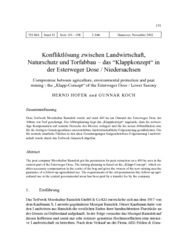Konfliktlösung zwischen Landwirtschaft, Naturschutz und Torfabbau – das “Klappkonzept“ in der Esterweger Dose / Niedersachsen
Hofer, Bernd
Koch, Gunnar
32: 191 - 198
Hofer, Bernd; Koch, Gunnar, 2002: Konfliktlösung zwischen Landwirtschaft, Naturschutz und Torfabbau – das “Klappkonzept“ in der Esterweger Dose / Niedersachsen. In: TELMA - Berichte der Deutschen Gesellschaft für Moor- und Torfkunde, Band 32: 191 - 198, DOI: 10.23689/fidgeo-2877.
 |
Dokument öffnen: |
Abstract:
The peat company Moorkultur Ramsloh got the permission for peat extraction on a 400 ha area in the eastern part of the Esterweger Dose. The mining planning is based on the „Klapp-Concept“, which enables necessary compensation in the centre of the bog and gives the owners of the new mining area the guarantee of a follow-up agricultural use. The requirements of the old permissions like follow-up agricultural use in the central governmental areas has been paid by a transfer fee by the company. Zusammenfassung:
Dem Torfwerk Moorkultur Ramsloh wurde auf rund 400 ha am Ostrand der Esterweger Dose der Abbau von Torf genehmigt. Der Abbauplanung liegt das „Klappkonzept“ zugrunde, dass die notwendige Kompensation auf zentrale Bereiche des Moores verlagert und für die neuen Abbauflächen eine für die dortigen Grundeigentümer unverzichtbare landwirtschaftliche Folgenutzung gewährleistet. Die für zentrale staatliche Flächen in den alten Genehmigungen festgeschriebene Folgenutzung Landwirtschaft wurde durch das Torfwerk finanziell abgelöst.

